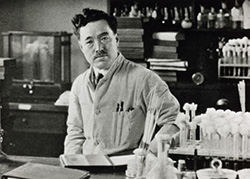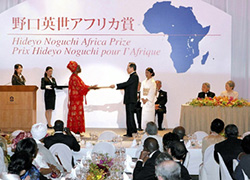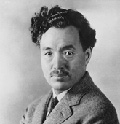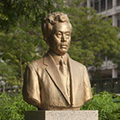Home > Highlighting JAPAN > Highlighting Japan APRIL 2013 > Hideyo Noguchi
Highlighting JAPAN
[SERIES] STUDENTS'CORNER: Ways of Japan
Hideyo Noguchi

Dr. Hideyo Noguchi
Credit: SCIENCE PHOTO LIBRARY/AFLO
Born in a small village in Fukushima Prefecture, Hideyo Noguchi suffered a serious burn injury as an infant, but overcame the deformity to his left hand to obtain a physician's license at the young age of twenty. In 1900, Noguchi traveled to the United States and worked as a researcher at the University of Pennsylvania and the Rockefeller Institute for Medical Research, where his work studying infectious diseases would be recognized with three Nobel Prize nominations.

Award ceremony for the Hideyo Noguchi Africa Prize at TICAD IV in May, 2008
Credit: YOMIURI SHIMBUN/AFLO
As a way to honor the doctor's achievements and continue his intentions, the Noguchi Memorial Institute for Medical Research was established with Japanese support at the University of Ghana in 1979. The Institute is one of the leading laboratories researching infectious diseases in Africa today.
In 2006, the Japanese government established the Hideyo Noguchi Africa Prize to honor individuals with outstanding achievements in the fields of medical research and medical services to combat infectious and other diseases in Africa. Following the first award at TICAD IV in 2008, the ceremony for the second Hideyo Noguchi Africa Prize will be held at TICAD V in June this year.

Credit: AP/AFLO
Q1: A portrait of Dr. Noguchi can be found on items in circulation in everyday Japanese life. What?
A. Postage stamps
B. Paper currency
C. Coins

Credit: AFLO
Q2: By what nickname was Dr. Noguchi known among his colleagues at research laboratories in the United States? (Photo: Statue of Dr. Noguchi in Ghana)
A. The human locomotive
B. The human printing press
C. The human dynamo
© 2009 Cabinet Office, Government of Japan






